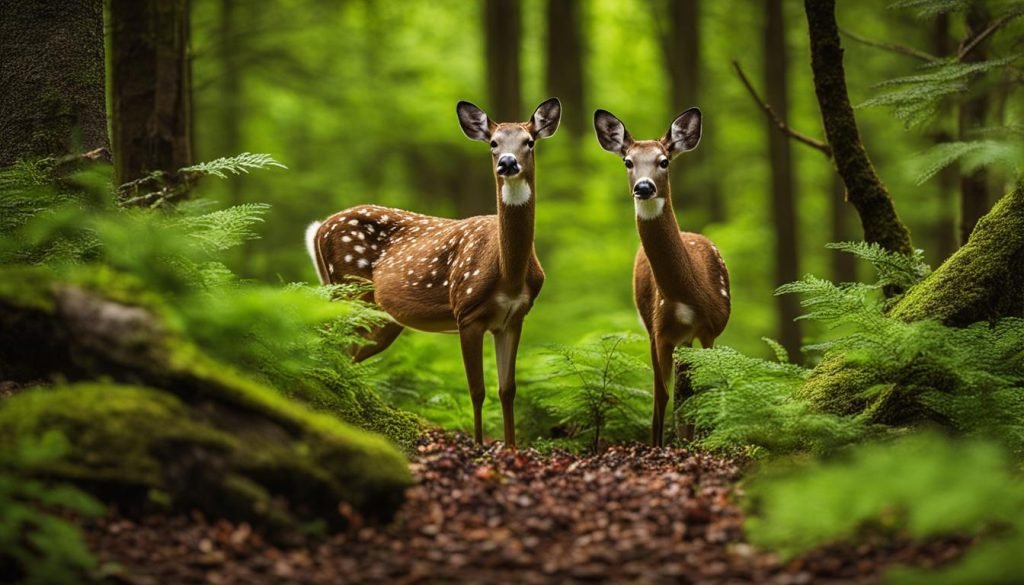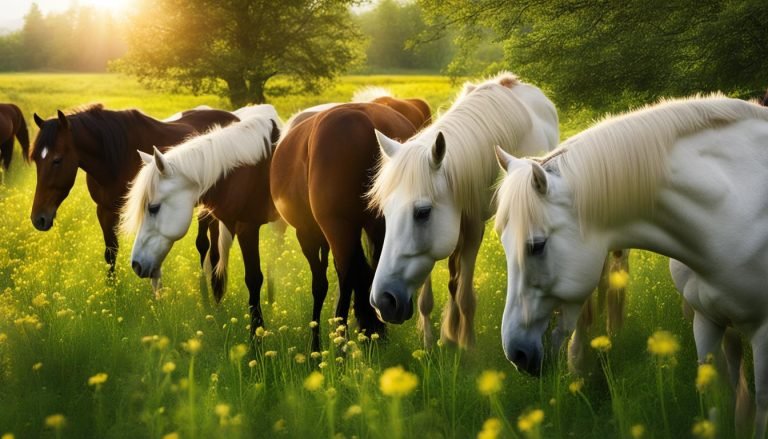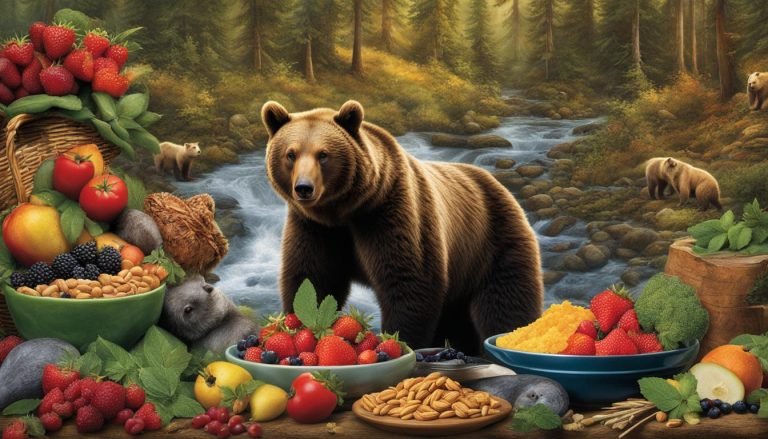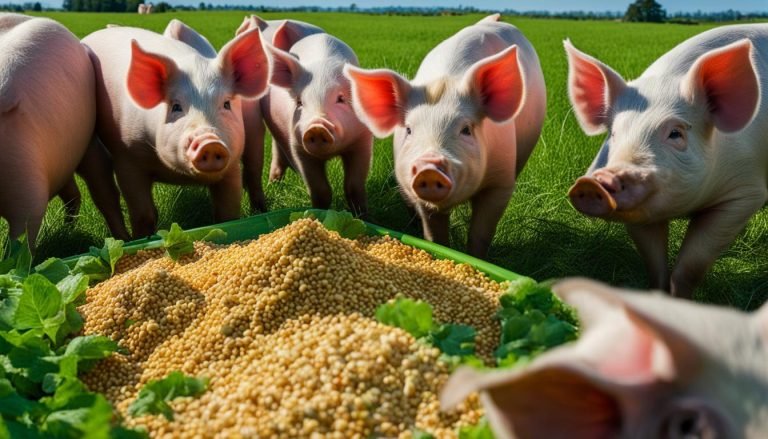What Do Deer Eat? – Deer Diet Guide
Deer are fascinating creatures with a unique diet that plays a crucial role in maintaining the balance of the ecosystem. Understanding their dietary habits, preferences, and nutritional needs is essential to comprehend their impact on the surrounding environment.
Deer are herbivores, which means they rely solely on plant-based foods for their sustenance. Their browsing behavior is influenced by factors such as season, habitat, and population. During the growing season, deer prefer succulent forage plants, while in the winter, they opt for woody vegetation.
The natural diet of deer consists of leaves, stems, buds, and shoots of various plants. Some of the forage plants that deer prefer include blackberry, blueberry, clover, dandelion, dogwood, maple, and oak. The nutritional needs of deer vary depending on factors such as age, sex, and reproductive status.
Deer play a vital role in the ecosystem by helping to shape the plant community through their browsing behavior. By consuming certain types of plants, they control their growth and promote the growth of others, which helps to maintain the balance of the ecosystem.
Deer Quiz
How well do you know deer? Test your knowledge here!


Key Takeaways:
- Deer are herbivores that rely solely on plant-based foods for their sustenance.
- The natural diet of deer consists of leaves, stems, buds, and shoots of various plants.
- Deer have distinct food preferences when it comes to vegetation and their browsing behavior is influenced by factors such as season and habitat.
- Understanding the nutritional needs of deer is essential to comprehend their impact on the surrounding environment.
- Deer play a vital role in the ecosystem by helping to shape the plant community through their browsing behavior.
Understanding Deer Feeding Behavior
As a copywriting journalist, I have come to understand that examining the feeding behavior of deer is crucial in comprehending what they eat. Deer feeding habits are influenced by their browsing behavior, which entails moving from one plant to another in search of food.
Deer are selective feeders, and their feeding habits vary depending on the season and the availability of food. During the summer months, deer tend to feed on herbaceous plants, forbs, and broad-leaved plants. However, in the fall, their diet shifts to woody plants such as shrubs, trees, and vines.
Deer use a browsing style of feeding, whereby they delicately nip off parts of a plant and then move on to the next. This feeding method is quite different from that of grazing animals such as cows, which use their teeth to tear off grass from the ground.
It is worth noting that deer feeding habits can have a significant impact on their environment. When deer overgraze on a particular plant or tree species, it can lead to reduced growth and even death of the plant. This can have a ripple effect on the ecosystem as other organisms that rely on the plant or tree also suffer from the loss of habitat and food sources.

“Deer use a browsing style of feeding, whereby they delicately nip off parts of a plant and then move on to the next.”
Overall, understanding deer feeding habits is vital in managing their population in the wild and ensuring the sustainability of their ecosystem. By gaining insight into their feeding behavior, researchers and wildlife managers can make informed decisions about conservation efforts and habitat restoration.
The Natural Diet of Deer
Deer have a natural diet that is primarily composed of forage plants. Forage plants are vegetation that deer rely on for sustenance. These plants have a higher nutritional value than other types of plants, making them essential in the diet of deer.
In the wild, deer consume a variety of different forage plants, including grasses, shrubs, and trees. Their natural diet is diverse and changes depending on the season and availability of food sources.
Some of the most commonly consumed forage plants for deer include:
| Forage Plants | Description |
|---|---|
| Grasses | Deer consume a variety of grasses, including bluegrass, fescue, and clover. Grasses provide deer with essential nutrients, including potassium and calcium. |
| Shrubs | Shrubs are an important source of food for deer, especially during the winter months when other food sources are scarce. Some of the most commonly consumed shrubs for deer include dogwood, sumac, and viburnum. |
| Trees | Trees are another essential food source for deer. They consume the twigs, leaves, and buds of many different tree species, including ash, maple, and oak. |
Other forage plants for deer include herbs, legumes, and vines.
It’s important to note that deer have evolved to consume a natural diet of forage plants. Consuming other types of vegetation, including ornamental plants, can be harmful to their health. As such, it’s important to provide deer with access to a diverse range of forage plants in their natural habitat.

Deer Food Preferences
Deer have a range of food preferences when it comes to vegetation. They are highly selective and choose specific plants based on their taste and nutritional value.
Some of the most commonly consumed vegetation by deer includes:
| Vegetation | Description |
|---|---|
| Browse | The twigs and leaves of woody plants. |
| Mast | The fruit, nuts, and acorns of trees and shrubs. |
| Grasses | Various types of grasses, including ryegrass, bluegrass, and fescue. |
| Forbs | Wildflowers and other non-woody plants, such as dandelions and clovers. |
Their food preferences can vary depending on the season. In the spring, deer tend to feed on young plants and leaves, while in the summer, they consume more grasses and forbs. During the fall and winter, they rely heavily on mast, such as acorns and nuts, to survive.
It is interesting to note that deer have adapted to live in areas where their preferred vegetation is abundant. For example, in areas where browse is plentiful, such as young forests, deer populations tend to be higher. Conversely, in areas where browse is scarce, such as mature forests, the deer population is often lower.
Overall, understanding the food preferences of deer can help us appreciate their dietary choices and their impact on the surrounding plant life. By studying their feeding habits, we can gain insight into their role in the ecosystem, and how they interact with other plant and animal species.
Seasonal Variation in Deer Diet
Deer are herbivores, and their diet can vary depending on the season. In this section, we will explore how their diet changes throughout the year and how they adapt to these changes.
Spring
In spring, deer crave fresh, succulent vegetation after a long winter of browsing on dry twigs and bark. They rely heavily on new shoots and leaves, which are rich in essential nutrients and moisture. Some of the plants that deer prefer during the spring include wildflowers like trillium and violets, tree buds, and the leaves of hardwood trees like ash, maple, and oak. Spring is also the time when many herbaceous plants start to bloom, providing a rich source of nectar and pollen for deer.
Summer
Summer is the time when deer have the most diverse range of food available to them. They take advantage of the abundance of flowering plants, leaves, fruits, and berries that spring up during this season. During this time of the year, deer feed on a range of vegetation, including clover, alfalfa, and soybeans. Additionally, they consume leaves and fruits from berry bushes like blackberries and raspberries.
Fall
In fall, when the leaves start to change color, deer feeds on acorns, beechnuts, and other tree nuts. They also eat fruits like apples and pears from orchards and berry bushes. They need to build up their fat reserves for the winter, and these food sources provide them with the necessary nutrients. Fall is the breeding season for deer, and bucks require a lot of energy to participate in the rut.
Winter
Winter is the toughest season for deer. The ground is covered in snow, and many plants are dormant or have lost their leaves. During this period, deer rely on twigs, branches, and buds to survive. They consume bark from trees, shrubs like dogwood and sumac, and needles from evergreen trees like fir and pine. In some cases, they can also dig for roots under the snow to find food.
Overall, the deer’s diet varies depending on the season, and they have adapted to use the available food sources to their advantage. It is essential to consider seasonal variations in their diet when managing deer populations and preserving their habitat.
Nutritional Needs of Deer
Deer have specific nutritional needs to maintain their health and well-being. As herbivorous species, they require a diet that provides them with sufficient amounts of protein, fat, carbohydrates, vitamins, and minerals.
Protein is essential for muscle growth and repair, while fats and carbohydrates provide energy for their daily activities. Vitamins and minerals are crucial for various bodily functions, including bone growth, immune system support, and reproduction.
Deer obtain these essential nutrients from their diet, which includes various forage plants such as grasses, leaves, and twigs. (nutritional needs of deer) However, their diet can vary depending on the season and the availability of food sources.
| Nutrient | Source |
|---|---|
| Protein | Legumes, alfalfa, clover, soybeans, corn, wheat, and oats |
| Fats | Nuts, acorns, and seeds |
| Carbohydrates | Grasses, forbs, and other herbaceous plants |
| Vitamins and Minerals | Leaves, twigs, and other forage plants, as well as natural mineral licks |
Deer also require access to clean water to stay hydrated and maintain their bodily functions. (nutritional needs of deer) Providing adequate water sources is essential, particularly during dry seasons when water may be scarce.
It is essential to ensure that deer have access to a balanced diet that provides them with all the necessary nutrients. If deer do not receive proper nutrition, they may become weakened, more susceptible to disease, and less able to survive harsh weather conditions.
Deer Food Sources
Deer are herbivores and rely on various sources of vegetation to meet their dietary needs. Some of the primary food sources for deer include:
| Food Source | Description |
|---|---|
| Browse | The tender shoots, leaves, and twigs of woody plants such as shrubs and young trees. |
| Forbs | Herbaceous plants such as clovers, dandelions, and asters that grow in open meadows and fields. |
| Grasses | Acorns, nuts, and other fruits are produced by trees such as oaks, hickories, and beeches. |
| Mast | Acorns, nuts, and other fruits produced by trees such as oaks, hickories, and beeches. |
During the winter months, deer rely heavily on browse and mast as other vegetation sources become less available or dormant. In contrast, during the spring and summer months, deer prefer to consume forbs and grasses as they are more abundant.
Deer are also known to supplement their diet with crops such as corn and soybeans, which can lead to conflicts between deer populations and farmers.
It is important to note that the availability of food sources can vary depending on geographical location, climate, and other environmental factors. For example, deer in the western United States may rely more heavily on sagebrush and other native plants, while deer in the eastern United States may rely more on acorns and other mast.
Understanding the various food sources of deer is crucial to managing their populations and ensuring their survival. By providing ample food sources and managing agricultural conflicts, we can help maintain healthy and sustainable deer populations.
The Impact of Deer Diet on the Ecosystem
Deer play a crucial role in maintaining the balance of the ecosystem. Their food preferences and browsing behavior have a significant impact on the environment.
The Vegetation Consumed by Deer
Deer are herbivores and consume a variety of vegetation, including grasses, forbs, and woody plants. However, they have distinct food preferences and tend to consume plants that are high in protein and low in fiber. This can lead to overgrazing of preferred plants, resulting in reduced vegetation cover and biodiversity.
The Browsing Behavior of Deer
Deer are selective browsers and tend to feed on the uppermost parts of plants, including leaves, buds, and shoots. This browsing behavior can alter the growth patterns of plants and even stunt their growth. Additionally, deer can cause damage to trees by removing bark from their trunks.
The Impact on the Ecosystem
The impact of deer diet on the ecosystem can be both positive and negative. On one hand, deer can help to maintain plant diversity by consuming dominant plant species and allowing less dominant species to thrive. On the other hand, their browsing behavior and food preferences can have a detrimental effect on vegetation cover and biodiversity.
Moreover, the impact of deer on the ecosystem extends beyond plant life. Overpopulation of deer can lead to increased competition for food and habitat, causing a decline in other wildlife populations. Additionally, deer can spread diseases to other wildlife and even to humans.
In conclusion, the diet of deer has a significant impact on the ecosystem. Their food preferences, browsing behavior, and population density all play a crucial role in shaping the environment in which they live. By understanding their role in the ecosystem, we can better manage and appreciate the intricate relationship between deer and their environment.
More About Deer:
- How Do Deer Mate? An Informative Guide
- How Long Do Deer Live? Deer Lifespan
- 15 Facts About Deer You Have Never Heard
- Deer Quiz: How Well Do You Know Deer?
Frequently Asked Questions
What do deer eat?
Deer primarily consumes forage plants, including grasses, leaves, twigs, and buds. Their diet can vary depending on the season and availability of food sources.
What are the natural diet preferences of deer?
Deer have a natural preference for specific forage plants, such as clover, alfalfa, dandelion, and various grasses. These plants provide the necessary nutrition for deer to thrive.
How does deer feeding behavior influence their diet?
Deer are browsers, meaning they selectively feed on certain plants rather than grazing on large areas. Their feeding behavior is influenced by factors such as plant availability, palatability, and nutrition content.
Do deer’s dietary choices change throughout the year?
Yes, deer’s diet can vary depending on the season. In spring and summer, they consume tender shoots, leaves, and grasses. In fall and winter, they rely more on woody browse, such as twigs and buds, to sustain themselves.
What are the nutritional needs of deer?
Deer require essential nutrients such as carbohydrates, proteins, fats, minerals, and vitamins to maintain their health. These nutrients are obtained from their diet and are crucial for growth, reproduction, and overall vitality.
Where do deer find their food sources?
Deer find their food sources in a variety of places, including open fields, forests, meadows, and even suburban areas. They rely on plants, shrubs, trees, and grasses to meet their nutritional needs.
How does the deer diet impact the ecosystem?
Deer play a vital role in shaping ecosystems through their dietary choices. Their feeding habits can influence plant populations, vegetation structure, and the overall balance of the ecosystem. Overgrazing or high deer populations can have negative impacts on vegetation and other wildlife species.







